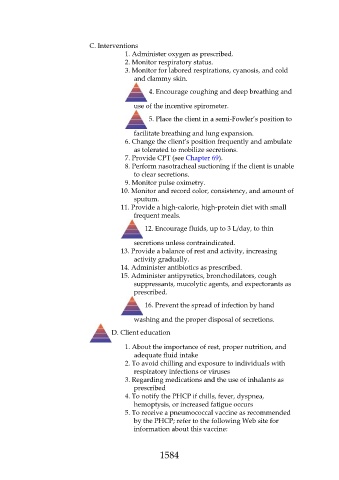Page 1584 - Saunders Comprehensive Review For NCLEX-RN
P. 1584
C. Interventions
1. Administer oxygen as prescribed.
2. Monitor respiratory status.
3. Monitor for labored respirations, cyanosis, and cold
and clammy skin.
4. Encourage coughing and deep breathing and
use of the incentive spirometer.
5. Place the client in a semi-Fowler’s position to
facilitate breathing and lung expansion.
6. Change the client’s position frequently and ambulate
as tolerated to mobilize secretions.
7. Provide CPT (see Chapter 69).
8. Perform nasotracheal suctioning if the client is unable
to clear secretions.
9. Monitor pulse oximetry.
10. Monitor and record color, consistency, and amount of
sputum.
11. Provide a high-calorie, high-protein diet with small
frequent meals.
12. Encourage fluids, up to 3 L/day, to thin
secretions unless contraindicated.
13. Provide a balance of rest and activity, increasing
activity gradually.
14. Administer antibiotics as prescribed.
15. Administer antipyretics, bronchodilators, cough
suppressants, mucolytic agents, and expectorants as
prescribed.
16. Prevent the spread of infection by hand
washing and the proper disposal of secretions.
D. Client education
1. About the importance of rest, proper nutrition, and
adequate fluid intake
2. To avoid chilling and exposure to individuals with
respiratory infections or viruses
3. Regarding medications and the use of inhalants as
prescribed
4. To notify the PHCP if chills, fever, dyspnea,
hemoptysis, or increased fatigue occurs
5. To receive a pneumococcal vaccine as recommended
by the PHCP; refer to the following Web site for
information about this vaccine:
1584

